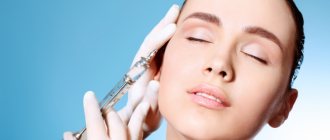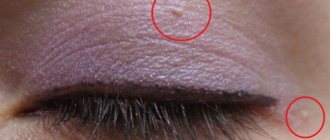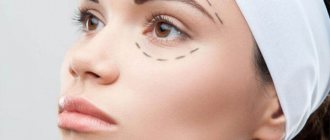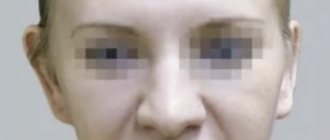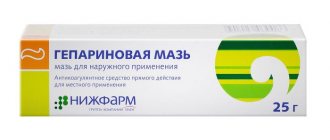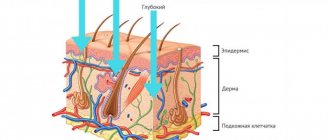- Recovery period
- When does the effect occur?
- Why didn't Dysport work?
- How long does the result last?
- Contraindications
- Dysport during pregnancy
- Complications
- Is Dysport dangerous for human health?
- How to choose between Dysport and Botox
Today you can literally erase some facial wrinkles from your face, and in one procedure.
However, getting a Dysport injection in a cosmetologist’s office is only half the battle. The result of the procedure depends not only on the professionalism of the doctor, but also on how the patient follows his recommendations. It is important to know what not to do after the Dysport procedure. For example, for 4-6 hours after the injection, it is forbidden to lie down, tilt your head or actively wince. There are also restrictions on playing sports, taking certain medications and drinking alcohol. Only close cooperation between the doctor and the patient guarantees the safety of the procedure and long-term effect. Sometimes Dysport does not rise at all or does not provide the expected relief from wrinkles on the forehead, near the eyes and marionette lines near the lips. The rehabilitation period will go smoothly if you follow simple rules.
Recovery period after botulinum toxin injection and skin care
On the 1st day after the procedure
- For 4-6 hours, do not take a horizontal position and do not massage the injection sites. No need to go to bed.
- Do not touch your face with your hands, which is important for hygienic reasons. Before injecting Dysport, the doctor will remove makeup and treat the area with an antiseptic, apply an anesthetic, and then apply a soothing cream.
- Don't bend over unnecessarily. This will cause redistribution of blood to the head area and expansion of the capillaries.
- Avoid hot drinks and spicy foods, which cause blood flow to the facial tissues. This is important for injections near the eyes and mouth.
- Don't squint, frown, or frown. It is better to use minimal facial expressions so that the drug is properly distributed in the small muscles located under the skin. If you are returning home from the clinic on a clear day, wear sunglasses.
- Do not scratch the injection sites.
- Don't wash your face. Neither hot nor cold water. Do not use makeup removers.
- Do not apply foundation, powder, blush or other cosmetics to the skin.
The doctor will prescribe treating the skin morning and evening with an antiseptic (miramistin or chlorhexidine) for 3-4 days to prevent infection from getting into the puncture sites. After this, the patient carefully applies a healing cream (for example, Bepanten) to the face without pressure.
On the 2nd day after the procedure
Physical activity is not allowed during the first 48 hours. Plan your days so that you not only miss a workout at the gym, but also avoid carrying heavy bags of groceries from the store.
Dysport has many supporters among specialists and patients
Within 1st week
- Do not engage in fitness, in the gym or other sports for at least 7 days. Then you can gradually return to training, but limiting the intensity at first.
- Don't smoke or smoke less. Nicotine does not directly interact with botulinum toxin, but smoking negatively affects blood vessels, lungs and the body in general.
- Don't drink alcohol. No alcoholic drinks and in any quantity. Partial neutralization of Dysport or its distribution into undesirable areas is possible.
- Do not go to the sauna, hammam, swimming pool or bathhouse, or take hot baths. Exposure to high temperatures and sudden changes in temperature will reduce the effect of the procedure or even provoke complications (ptosis of the eyelids, impaired facial expression in individual muscles, swelling).
- Do not sunbathe in the sun or in a solarium.
Within 2 weeks
- You cannot take antibiotics because Dysport is not compatible with them. And not only 2 weeks after, but also 2 weeks before botulinum therapy. This will negate the effect of botulinum toxin or cause bruising and swelling. This is especially true for antibiotics of the aminoglycoside group, because they affect neuromuscular conduction. If an emergency situation arises when you cannot do without an antibiotic, then warn your cosmetologist about the recent procedure. Only a specialist can choose the right remedy to prevent complications.
- Do not take B vitamins so as not to weaken the effect of Dysport. Aspirin and sleeping pills are also contraindicated. If you are taking any pills, tell your doctor about it.
- Don't vaccinate.
- Avoid facial massage: this will speed up the removal of the drug from the tissues, therefore reducing the effect of the procedure.
- Do not engage in face building - any exercises on the face will weaken the effect of the medicine.
Dysport®
General recommendations
Recommended doses of Dysport® 500 IU are drug-specific and are not interchangeable with other botulinum toxin A preparations;
Dysport® 500 units should be administered by specialists trained in the administration of treatment.
Focal spasticity of the upper limbs in adults
The maximum total single dose should not exceed 1000 units.
When treating focal spasticity of the upper extremities, Dysport® is diluted to a concentration of 100 U/ml, 200 U/ml or 500 U/ml (see Table 5). The drug is used as intramuscular injection according to the scheme given below.
Dosage during initial and subsequent treatment sessions should be individualized and based on the size, number and location of muscles involved, degree of spasticity, presence of local muscle weakness, patient response to previous treatment and/or history of adverse events during treatment with botulinum toxin complex type A - hemagglutinin.
In clinical studies, doses of 500 IU and 1000 IU were distributed among the muscles involved in the injection session and are indicated in the table below.
The number of injection points depends on the volume of muscles into which injections will be made.
No more than 1 ml of solution can be injected into one point.
Table 1. Dosage of Dysport® for the treatment of focal spasticity of the upper limbs by muscle
| Injected muscles | Recommended doses of Dysport® (IU) |
| Flexor carpi radialis (m. flexor carpi radialis (FCR)) | 100-200 |
| Flexor carpi ulnaris (m. flexor carpi ulnaris (FCU)) | 100-200 |
| Flexor digitorum profundus (m. flexor digitorum profundus (FDP)) | 100-200 |
| Superficial flexor of the fingers (m. flexor digitorum superficialis (FDS)) | 100-200 |
| Flexor pollicis longus (m. flexor pollicis longus) | 100-200 |
| Muscle adductor pollicis (m. adductor pollicis) | 25-50 |
| Brachial muscle (m. brachialis) | 200-400 |
| Brachioradialis muscle (m. brachioradialis) | 100-200 |
| Biceps brachii (m. biceps brachii) | 200-400 |
| Pronator teres (m. pronator teres) | 100-200 |
| Triceps brachii muscle (m. triceps brachii) long head | 150-300 |
| Pectoralis major muscle (m. pectoralis major) | 150-300 |
| Subscapularis muscle (m. subscapularis) | 150-300 |
| Latissimus dorsi (m. latissimus dorsi) | 150-300 |
Although the immediate injection site is determined by palpation, it is recommended to use standard determination techniques such as electromyography, electrical stimulation or ultrasound to select the injection site.
Repeated injections of Dysport® should be carried out after the effect of the previous injection has subsided, but not earlier than after 12 weeks. Most patients in clinical studies received repeat injections after 12 to 16 weeks; however, some patients had a longer effect - up to 20 weeks. The degree and pattern of muscle spasticity at the time of repeat injection may require changes in the dose of Dysport® and the muscles being injected. Clinical improvement can be expected a week after injections of Dysport®.
Elderly patients (≥ 65 years): Clinical experience has not shown differences in response between elderly and younger patients. Elderly patients should be evaluated for tolerance to botulinum toxin type A due to the high incidence of comorbidities and other drug therapies.
Focal spasticity of the lower extremities in adults
During one treatment session, a dose of up to 1500 units can be administered intramuscularly.
When treating focal spasticity of the lower extremities, Dysport® is diluted to a concentration of 100 IU/ml, 200 IU/ml or 500 IU/ml (see Table 5). The drug is used as intramuscular injection according to the scheme given below.
Dosage for initial and subsequent treatment sessions should be individualized and based on the size and number of muscles involved, the degree of spasticity, the presence of local muscle weakness and the patient's response to previous treatment. In clinical studies, doses of 1000 IU and 1500 IU were distributed among the muscles involved in the injection session and are indicated in the table below.
No more than 1 ml of solution can be injected into one point.
Table 2. Dosage of Dysport® for the treatment of focal spasticity of the lower extremities by muscle
| Muscle | Recommended dose range for muscle (IU) | Number of injection points per muscle |
| Main target muscles | ||
| Soleus muscle (m. soleus) | 300-550 units | 2-4 |
| Calf muscle (m. gastrocnemius) | ||
| Medial head | 100-450 units | 1-3 |
| Lateral head | 100-450 units | 1-3 |
| Distal muscles | ||
| Posterior tibialis muscle (m. tibialis posterior) | 100-250 units | 1-3 |
| Flexor digitorum longus (m. flexor digitorum longus) | 50-200 units | 1-2 |
| Flexor digitorum brevis (m. flexor digitorum brevis) | 50-200 units | 1-2 |
| Flexor pollicis longus (m. flexor hallucis longus) | 50-200 units | 1-2 |
| Flexor pollicis brevis (m. flexor hallucis brevis) | 50-100 units | 1-2 |
| Proximal muscles | ||
| Rectus femoris (m. rectus femoris) | 100-400 units | 1-3 |
| Hamstring muscles | 100-400 units | 1-3 |
| Large adductor muscle of the thigh (m. adductor magnus) | 100-300 units | 1-3 |
| Long adductor muscle of the thigh (m. adductor longus) | 50-150 units | 1-2 |
| Short adductor muscle of the thigh (m. adductor brevis) | 50-150 units | 1-2 |
| Gracilis muscle (m. gracilis) | 100-200 units | 1-3 |
| Gluteus maximus muscle (m. gluteus maximus) | 100-400 units | 1-2 |
The degree and pattern of spasticity may change at the time of reinjection, which may require adjustment of the dose of Dysport® and selection of target muscles. Although the immediate injection site is determined by palpation, it is recommended to use standard determination techniques such as electromyography, electrical stimulation or ultrasound to select the injection site.
Repeated injections of Dysport® are carried out every 12-16 weeks or less frequently, based on the return of clinical symptoms, but not earlier than 12 weeks after the previous injection.
Focal spasticity of the upper and lower extremities in adults
If it is necessary to treat spasticity of the upper and lower extremities during one treatment session, the dose of Dysport® for injection into each extremity should be adapted to individual needs and should not exceed a total dose of 1500 units.
Elderly patients (≥ 65 years): Clinical experience has not shown differences in response between elderly and younger patients. Elderly patients should be assessed for tolerance to Dysport® due to the high incidence of concomitant diseases and therapies with other drugs.
Focal spasticity of the lower extremities in children aged 2 years or older
When treating focal spasticity of the lower extremities in children, Dysport® is diluted to obtain the required concentrations in accordance with Table 5. The drug is used for intramuscular injection according to the scheme given below.
Initial and subsequent doses during injection sessions are individualized according to the number, size, location and degree of spasticity of the target muscles, the presence of local muscle weakness, the patient's response to previous treatment and/or previous adverse reactions to botulinum toxin.
The total maximum dose of Dysport administered during an injection session should not exceed 15 units/kg when administered to only one lower limb or 30 units/kg when administered to both lower limbs.
The total dose of Dysport® per treatment session should not exceed 1000 units or 30 units/kg (the lesser of the two).
The total administered dose is distributed between the spastic muscles of the lower limb(s). No more than 0.5 ml of the drug solution can be injected into one point. If it is necessary to inject more than 0.5 ml of solution into one muscle, the total volume of the solution is distributed over several injection points. The table below shows the recommended doses and muscles for administration.
Table 3. Dosage of Dysport® for the treatment of focal spasticity of the lower extremities in children by muscle
| Muscle | Recommended dose range for muscle of one limb (IU/kg body weight) | Number of injection points per muscle/muscle group |
| Distal | ||
| Calf muscle (m. gastrocnemius) | 5-15 units/kg | Up to 4 |
| Soleus muscle (m. soleus) | 4-6 units/kg | Up to 2 |
| Posterior tibialis muscle (m. tibialis posterior) | 3-5 units/kg | Up to 2 |
| Proximal | ||
| Muscles of the back of the thigh (m. semitendinosus, m. semimembranosus, m. biceps femoris) | 5-6 units/kg | Up to 2 |
| Adductor muscles of the thigh (m. adductor longus, m. adductor brevis, m. adductor magnus, m. gracilis) | 3 - 10 units/kg | Up to 2 |
| Total dose | Regardless of whether the injections are carried out only in the distal muscles or only in the proximal ones, or in one treatment session the injections are carried out in both the distal and proximal muscles - the total dose is no more than 15 IU / kg per limb. | |
Although the immediate injection site is determined by palpation, it is recommended to use standard determination techniques such as electromyography, electrical stimulation or ultrasound to select the injection site.
The dosage regimen should be reduced in children:
- with the presence of concomitant diseases associated with problems, in particular with swallowing or breathing;
- those whose target muscles are small;
- who require multi-level injections;
- in those receiving injections under general anesthesia.
In all cases, when choosing a drug dose, an individual assessment of the risk/benefit ratio is required in order to reduce undesirable effects and, in particular, the risk of spread of the toxin remote from the injection site.
Repeated injections of the drug Dysport® are carried out after the effect of the previous injection has decreased, but not earlier than after 12 weeks. Most patients in clinical studies received repeat injections after 16-22 weeks, although some patients had longer-lasting effects of up to 28 weeks. The degree and pattern of spasticity may change at the time of reinjection, which may require adjustment of the dose of Dysport® and selection of target muscles. Clinical improvement usually occurs within 2 weeks after injections of Dysport®.
Focal spasticity of the upper extremities in children aged 2 years or older
When treating focal spasticity of the upper extremities in children, Dysport® is diluted to obtain the required concentrations in accordance with Table 5. The drug is used for intramuscular injection according to the scheme given below.
Dosage for initial and subsequent treatment sessions should be individualized and based on the size, number and location of the muscles involved, the degree of spasticity, the presence of local muscle weakness, the patient's response to previous treatment and/or a history of adverse reactions to botulinum toxin. .
The maximum dose of Dysport® administered during an injection session into one upper limb should not exceed 16 units/kg or 640 units (the lesser of the two). When administering the drug to both upper extremities during an injection session, the maximum dose of Dysport® should not exceed 21 IU/kg or 840 IU (the lesser of the two).
The total administered dose is distributed between the spastic muscles of the upper limb(s). No more than 0.5 ml of the drug solution can be injected into one point. The table below shows the recommended doses and muscles for administration.
Table 4. Dosage of Dysport® for the treatment of focal spasticity of the upper extremities in children by muscle
| Muscle | Recommended dose range for the muscle of one upper limb (IU/kg body weight) | Number of injection points per muscle |
| Brachial muscle (m. brachialis) | 3-6 units/kg | Up to 2 |
| Brachioradialis muscle (m. brachioradialis) | 1.5-3 U/kg | 1 |
| Biceps brachii (m. biceps brachii) | 3-6 units/kg | Up to 2 |
| Pronator teres (m. pronator teres) | 1-2 units/kg | 1 |
| Square pronator (m. pronator quadratus) | 0.5-1 U/kg | 1 |
| Flexor carpi radialis (m. flexor carpi radialis (FCR)) | 2-4 units/kg | Up to 2 |
| Flexor carpi ulnaris (m. flexor carpi ulnaris (FCU)) | 1.5-3 U/kg | 1 |
| Flexor digitorum profundus (m. flexor digitorum profundus (FDP)) | 1-2 units/kg | 1 |
| Superficial flexor of the fingers (m. flexor digitorum superficialis (FDS)) | 1.5-3 U/kg | Up to 4 |
| Flexor pollicis brevis (m. flexor pollicis brevis) | 0.5-1 U/kg | 1 |
| Muscle opponens pollicis (m. opponens pollicis) | 0.5-1 U/kg | 1 |
| Muscle adductor pollicis (m. adductor pollicis) | 0.5-1 U/kg | 1 |
| Total dose | Up to 16 U/kg in one upper limb (and not exceeding 21 U/kg in both upper limbs) | |
Despite the fact that the immediate injection site can be determined based on anatomical landmarks and palpation, it is recommended to additionally use electromyography, electrical stimulation or ultrasound to more accurately position the needle and select the injection site.
Repeated injections of the drug Dysport® are carried out after the effect of the previous injection has decreased, but not earlier than after 16 weeks. Most patients in clinical studies received repeat injections after 16-28 weeks, although some patients had longer-lasting effects of up to 34 weeks. The degree and pattern of spasticity may change at the time of reinjection, which may require adjustment of the dose of Dysport® and selection of target muscles.
Focal spasticity of the upper and lower extremities in children 2 years of age or older
If it is necessary to treat spasticity of the upper and lower extremities in children aged 2 years or older during one treatment session, the dose of Dysport® should not exceed 30 IU/kg or 1000 IU (the lesser of the two).
Repeat injections in the upper and lower extremities should be considered no sooner than 12 to 16 weeks after the previous injection session. The optimal time for retreatment should be determined based on individual progress and response to treatment.
Cervical dystonia in adults
When treating cervical dystonia, Dysport® is diluted to a concentration of 500 U/ml (see Table 5). The drug is used as intramuscular injection according to the scheme given below.
Doses recommended for the treatment of cervical dystonia are used in adult patients of all ages who have normal body weight and satisfactory development of the neck muscles. A reduction in the dose of the drug is possible if the patient is significantly underweight or in elderly people with reduced muscle mass.
The initial total single dose of the drug for the treatment of cervical dystonia is 500 units. This dose is distributed between two or three of the most active muscles of the neck.
For rotational torticollis, the dose of the drug (500 units) is distributed as follows: 350 units into the splenius capitis muscle, ipsilateral to the direction of head rotation, and 150 units into the sternocleidomastoid muscle, contralateral to the rotation.
For laterocollis (head to shoulder tilt), the dose of the drug (500 units) is distributed as follows: 350 units are injected ipsilaterally into the splenius capitis muscle (m. splenius capitis) and 150 units ipsilaterally into the sternocleidomastoid muscle (m. sternocleidomastoideus). In cases involving shoulder elevation due to the trapezius muscle (m. trapezius) or the muscle that lifts the scapula (m. levator scapulae), treatment may be required according to visible muscle hypertrophy or according to electromyographic examination. When injection into three muscles is required, a dose of 500 IU is distributed as follows: 300 IU of the drug is injected into the splenius capitis muscle, 100 IU into the sternocleidomastoid muscle (m. sternocleidomastoideus) and 100 IU into the third muscle (trapezius muscle or levator scapulae muscle).
For retrocollis (tilting the head back), a dose of 500 IU of the drug is distributed as follows: 250 IU in each splenius capitis muscle. Bilateral injections into the splenius capitis muscle may increase the risk of neck muscle weakness.
For the treatment of other forms of cervical dystonia, the use of electromyography (EMG) is of great importance to identify and administer the drug to the most active muscles. EMG should be used to diagnose all complex forms of cervical dystonia or when re-examining patients with no positive dynamics after drug administration, for injections into deep muscles and in patients with excess body weight and difficult-to-palpable neck muscles.
When subsequently prescribing the drug, doses can be adapted in accordance with the effect obtained and the side effects encountered. Recommended total doses range from 250 to 1000 units; the use of higher doses may be accompanied by an increase in the incidence of side effects, in particular dysphagia. The maximum total single dose should not exceed 1000 units.
Injections can be repeated every 16 weeks or as needed, but no more than once every 12 weeks.
The safety and effectiveness of Dysport® in the treatment of cervical dystonia in children has not been confirmed.
Blepharospasm and hemifacial spasm in adults
When treating blepharospasm and hemifacial spasm, Dysport® is diluted to a concentration of 200 U/ml (see Table 5). The drug is used as a subcutaneous injection medially and laterally into the junction between the preseptal and orbital parts of the superior and inferior parts of the orbicularis oculi muscle.
Based on the dose range used in clinical studies, the starting dose of Dysport® for the treatment of blepharospasm is 40 units per eye (based on efficacy/tolerability ratio).
The maximum dose for the treatment of blepharospasm and hemifacial spasm should not exceed 120 units per eye.
Injections in a volume of 0.05 ml (10 units) should be carried out medially and laterally into the connection between the preseptal and orbital parts of the upper (3 and 4) and lower (5 and 6) parts of the circular muscle (m. orbicularis oculi) of each eye. For injections into the upper eyelid, in order to reduce the risk of ptosis, the needle should be directed away from the center so as not to touch the muscle that lifts the upper eyelid (m. levator palpebrae superioris). Below is a diagram showing where the injections will take place.
Injections should be repeated approximately every 12 weeks or as indicated to prevent recurrence of symptoms (but not more frequently than every 12 weeks).
Depending on the severity of the disease, if the effect of the previous injection was not achieved, with each subsequent administration of the drug, the total dose should be increased to:
- 60 units/eye (eg, 0.05 ml (10 units) medially and 0.1 ml (20 units) laterally),
- 80 units/eye: (eg, 0.1 ml (20 units) medially and 0.1 ml (20 units) laterally),
- or up to 120 units/eye: (eg, 0.1 ml (20 units) medially and 0.2 ml (40 units) laterally), above and below each eye, according to the regimen described previously. If spasm affects visual acuity, additional injection points into the frontal muscle (m. frontalis) above the eyebrow (1 and 2) can also be used. Doses of 80 units and 120 units per eye have a longer lasting effect. However, the incidence of adverse reactions, including ptosis, is dose dependent.
In case of unilateral blepharospasm, injections should be limited to the area of the affected eye.
Patients with hemifacial spasm are treated in the same way as patients with unilateral blepharospasm.
Recommended doses are used in adults of any age, including elderly patients.
The safety and effectiveness of Dysport® in the treatment of blepharospasm and hemifacial spasm in children has not been confirmed.
Hyperhidrosis of the axillary region
When treating axillary hyperhidrosis, Dysport® is diluted to a concentration of 200 U/ml (see Table 5). The drug is used intradermally according to the schemes given below.
The recommended starting dose for the treatment of axillary hyperhidrosis is 100 units per axillary area. If the desired effect is not achieved, then a subsequent increase in the dose to 200 IU of Dysport® is possible. The maximum single dose should not exceed 200 units per axillary area.
The area of drug administration is determined by Minor's test.
The test is carried out before treatment and, if necessary, dynamically, at room temperature (22 - 24 ° C) after the patient has rested for 15 minutes.
To carry out the test you need:
- 5% alcohol solution of iodine;
- potato starch;
- marker;
- antiseptic;
- brush;
- gauze napkins.
The patient is in a supine position with his hands under his head. The sweating area is treated with a 5% alcohol solution of iodine and after 1 minute a thin layer of potato starch is applied to this area with a napkin or brush. The test results are assessed after 5 minutes. In the presence of sweating, the treated surface is visually observed to turn blue. The intensity of color (from pale blue to blue-black) correlates with sweating activity. After the test, the area of hyperhidrosis is marked with a marker, then the starch is washed off with alcohol or another antiseptic.
Intradermal injections are carried out at ten points in each axillary region, 10 units of the drug in a volume of 0.05 ml are injected into each point, i.e. 100 units per area. In most cases, the recommended starting dose suppresses sweating for up to 48 weeks. The frequency of repeated injections is determined individually when the initial level of sweating is restored, but not more often than once every 12 weeks. If there is any evidence of a cumulative effect with repeated injections, the timing of repeat injections is determined individually for each patient.
The safety and effectiveness of Dysport® in the treatment of axillary hyperhidrosis in children has not been confirmed.
Temporary improvement in the appearance of moderate to severe facial hyperkinetic folds (expression wrinkles) in adult patients under 65 years of age when the severity of these wrinkles has a significant psychological impact on the patient
When treating facial wrinkles, Dysport® is diluted to a concentration of 200 U/ml (see Table 5). The drug is used according to the schemes given below.
The main area of application of Dysport® for cosmetic correction is the upper half of the face. The lower half of the face and neck are corrected by injecting botulinum toxin much less frequently.
When carrying out injections, it is recommended to use sterile needles of 29-30 G caliber. The total recommended dose for a single injection in all four areas (eyebrow area, forehead area, outer corner of the eye and dorsum of the nose) should not exceed 200 IU.
Eyebrow area
To correct vertical folds in the eyebrow area, injections of the drug are made into the corrugator supercilii muscle (m. corrugator supercilii) 8-10 units per 2-4 points and into the procerus muscle (m. procerus) 5-10 units per 2 points. The total dose ranges from 42 to 100 units.
Forehead area
Elimination of hyperkinetic folds in the forehead area is carried out by injecting the drug into the area of maximum tension of the frontal muscle (m. frontalis). The number of injection points can be arbitrary. All of them should be located 2 cm above the eyebrow line, on the same line or in a V-shape. The optimal total dose of Dysport® in this area is 30-40 units (maximum 90 units) at a rate of 5-15 units per point, the total number of points is 4-6.
Outer corner of the eye area
Correction of folds in the area of the outer corner of the eye (“crow’s feet”) is carried out by subcutaneous injection into points located 1 cm lateral from the outer corner of the eye, at the rate of 5-15 IU of Dysport® per injection point. The number of points is from 2 to 4 for each eye. The maximum recommended total dose on both sides is 120 units.
The frequency of repeated injections depends on the timing of restoration of facial muscle activity. The duration of the effect is 3-4 months.
If an adequate dose of the drug was administered during the first injection, then during the second and subsequent injections the total dose of Dysport® can be reduced by 15-20 IU for the appropriate areas. In this case, it is possible to increase the interval between injections of the drug to 6-9 months. If the initial dose of the drug was insufficient, then with repeated injections it should be increased.
Dorsal area of the nose
To correct wrinkles in the dorsum of the nose, injections are made into the middle of the belly of the nasal muscles. The dose is distributed at 5-10 units to 1-2 points in each muscle.
Insertion points
— — correction of the eyebrow area
▲ — correction of the forehead area
■ — correction of the nasal bridge area
♦ — correction of the outer corner of the eye
The muscle relaxant effect of the drug Dysport® on the facial muscles of the face is clinically manifested on days 2-3 after administration and reaches a maximum on days 14-15. Recommended doses of Dysport® for use in aesthetic medicine do not cause systemic side effects.
Use in children
The safety and effectiveness of botulinum toxin type A therapy for hyperkinetic wrinkles in children under 18 years of age has not been established.
Rules for preparing solution for injection
Remove the protective plastic tamper evident cap from the bottle.
When diluting the drug, do not open the bottle by removing the stopper. Immediately before diluting the contents of the bottle, the central part of the stopper should be treated with alcohol. The lyophilisate is diluted by introducing a regulated volume of 0.9% sodium chloride solution for injection into the bottle by piercing the stopper with a sterile needle of size 23 or 25 (in the case of correction of facial wrinkles, it is recommended to use needles of caliber 29-30 G).
For each indication for use, the required concentrations are specific.
Table 5.
| Received dose in units/ml | Amount of solvent (0.9% sodium chloride solution for injection), ml |
| 500 | 1,0 |
| 200 | 2,5 |
| 100 | 5 |
The resulting solution is a colorless transparent liquid. The diluted drug can be stored for no more than 24 hours at a temperature of 2 °C to 8 °C.
When does the effect occur after Dysport?
The drug begins to act after 7–14 days (depending on the characteristics of the body). During this period, it is important to scrupulously follow the cosmetologist’s prescriptions in order to avoid unwanted consequences. Under the influence of Dysport, muscle motor activity gradually weakens. Small expression wrinkles are smoothed out, deep static wrinkles become less pronounced, and the surface of the skin becomes smooth.
The doctor will see the final result after the procedure in 2 weeks and will make a correction if the effect was insufficient. Experienced cosmetologists act delicately, introducing the minimum dose of the drug possible for the patient at the first session. It's better to add it later than to fight the mask effect.
Some people believe that botulinum therapy gets rid of any wrinkles on the forehead, between the eyebrows, etc. This is only partly true. For example, it will not be possible to eliminate deep static wrinkles between the eyebrows, which no longer disappear when the forehead muscles are relaxed. Wrinkles will become less noticeable. When the patient wants to completely erase these furrows, the cosmetologist, after Dysport, injects hyaluronic acid into the wrinkle. The combination of botulinum toxin type A with contour plastic surgery gives the best effect.
Thin needles are used to insert Dysport
Special instructions for the use of the drug Dysport
Warning and safety precautions. Cases of side effects have been reported that resulted from distant spread of the action of botulinum toxin from the injection site. Patients receiving therapeutic doses of the drug may experience severe muscle weakness. The risk of such side effects may be reduced by using the lowest effective dose and not exceeding recommended doses. Treatment with Dysport should only be carried out by a specialist who has experience in diagnosing and treating such conditions and has been trained in the use of Dysport. The drug is used with caution and under strict medical supervision in patients with subclinical and clinical manifestations of neuromuscular conduction disorders. Such patients may have increased sensitivity to drugs such as Dysport, which may manifest as severe muscle weakness. Patients with impaired neuromuscular transmission, difficulty swallowing and breathing are at higher risk for these effects. Treatment of such patients should be carried out under the supervision of a specialist in cases where the expected benefit of treatment outweighs the risk. It is necessary to warn patients and those accompanying them about the need for emergency assistance in case of problems with swallowing, speech and breathing problems. In children with dynamic foot deformity caused by spasticity due to cerebral palsy, the drug can be used starting from 2 years of age. Instructions for processing drug residues. Immediately after the injection, the remaining solution in the vial and syringe should be inactivated with diluted sodium hypochlorite solution (containing 1% active chlorine). All ancillary materials that have been in contact with the drug must be disposed of in accordance with hospital practice standards. Spilled medication should be removed using an absorbent cloth moistened with diluted sodium hypochlorite solution.
Why didn't Dysport work?
Unfortunately, there are cases where Dysport did not eliminate facial wrinkles.
- The patient did not follow the doctor's recommendations. I started playing sports early, so part of the drug did not work due to increased blood flow.
- Initially, the dose of the drug was chosen too low. If a patient tries Dysport for the first time, the doctor uses the minimum dose to understand the response of the individual patient's muscles to the drug.
- Features of the body. For example, Dysport “does not get up” due to the patient’s fast metabolism. This requires correction.
- The patient forgot to tell the doctor about any disease, so the specialist took an incorrect history and, therefore, erroneously selected the dose and even the drug itself.
- The storage conditions of the bottle with botulinum toxin were violated; an error was made when diluting the drug. By the way, it is better to refuse the procedure in beauty salons and entrust this procedure to a cosmetologist in a licensed clinic.
- Appeal not to a dermatocosmetologist, but to a cosmetologist without medical education who knows little about the anatomy and architectonics of the face.
Indications for use of the drug Dysport
- blepharospasm;
- hemifacial spasm;
- spastic torticollis;
- spasticity of the arm after a stroke;
- spastic equinus foot deformity in adults after stroke;
- hyperkinetic (expressive) facial wrinkles in adults;
- dynamic deformation of the foot of spastic origin in children with cerebral palsy;
- anal fissure;
- local hyperhidrosis (palms, feet, armpits);
- tension headache;
- esophageal achalasia;
- hyperreflexia of the bladder.
How long does the result last?
The effect lasts 4-6 months, after which the procedure is repeated. To achieve lasting results, dermatocosmetologists advise administering the drug 2-3 times a year. As a result, the bad habit of frowning disappears even without the influence of the drug. After 2-4 years of regular botulinum therapy, they begin to inject Dysport less frequently. The muscles are kept relaxed, wrinkles are smoothed out and new ones are not formed. You will forget about the “crow’s feet” around the eyes, the “furrows of anger” on the forehead and the puppet wrinkles at the corners of the lips, giving the face a mournful expression.
At what age can you do Dysport?
Like any cosmetic invasive procedure, botulinum therapy is permitted from the age of 18. The upper limit for the age of injection use has not been established. In principle, the procedure will have a noticeable effect at any time.
However, cosmetologists call the most optimal age to start using Dysport 25-30 years. It is at this time that the first minor facial changes appear, by controlling which you can slow down the aging process and delay its manifestation in subsequent years.
Contraindications to injections
There are contraindications not only after Dysport, but also before the procedure.
Absolute:
- oncological processes;
- diabetes;
- blood diseases;
- autoimmune problems;
- pregnancy (there are no studies on the effect of botulinum toxin on the fetus);
- lactation (the drug may pass into breast milk);
- severe allergic reactions in the past (anaphylactic shock, Quincke's edema, generalized urticaria).
Relative:
- acute viral and bacterial infections (ARVI, acute respiratory infections, influenza, coronavirus, etc.);
- inflammation of the skin in the area where the drug is to be administered;
- herpes on the lips in the active stage.
2 weeks after recovery, administration of Dysport is allowed.
A smooth and even forehead is a reality
Dysport during pregnancy
Any botulinum toxins are contraindicated in pregnant women. Today there is no serious scientific data on the consequences for the child. Animal studies have shown reproductive toxicity when high doses of the drug were administered, causing maternal toxicity. There have also been no experiments to determine whether Dysport passes into breast milk, so nursing mothers should not receive such injections.
If a woman finds out about her pregnancy after the procedure, she should inform her obstetrician-gynecologist about this. In the first 3 weeks of the obstetric period, the embryo has not yet penetrated into the mucous membrane of the uterus, which means that the medicine will not affect it. Note: implantation occurs on average 7-8 days after fertilization, i.e. approximately 19-25 days after the start of the last menstruation. There is no reason to panic, especially considering that the substance, after being introduced into the tissue, exists in active form for no more than one hour and is eliminated from the body within 72 hours.
Complications after Dysport
If you tell your doctor in detail about your health before the procedure and follow the instructions after the injection, you will avoid negative consequences.
Side effects:
- Pain at the injection site, headache.
- Hematomas at the injection site.
- Lowering or raising of the eyebrows with injections in the forehead and between the eyebrows.
- Ptosis of the upper eyelid, which is reversible and disappears by the end of 3-4 weeks after the injection.
- Asymmetry, which occurs when the drug is administered incorrectly or is unevenly distributed in the muscles. So, a crooked smile will appear or one eyebrow will rise higher than the other.
There is a common myth about the negative effects of Dysport on the eyes (i.e. vision), which has no basis.
Possible side effects
In the first 1-2 days after injections, the following may occur:
- Slight swelling, redness, small hematomas around the needle wound.
- Feeling of lethargy, muscle weakness in the treated area.
- Weakness, dizziness, headache.
These symptoms are a reaction to the drug, go away on their own, and do not require seeking help.
If, after using Dysport, severe muscle weakness in the body, allergic reactions, or other symptoms are observed, you should consult a doctor.
Dysport or Botox – what to choose
Botox and Dysport have long been used in cosmetology and neurology. Scientists have proven their safety and effectiveness. Despite the fact that a serious poison, botulinum, is used to smooth out wrinkles, there are no toxic reactions when using these drugs. The active ingredient in both drugs is purified and weakened botulinum neurotoxin type A. The difference lies in their concentration in the bottle. 1 unit of Botox corresponds to 2.5-3 units of Dysport. The price of the procedure is similar, so the choice of drug remains with the doctor in each specific case.
Treat your health with care. Before administering Dysport, study the contraindications before and after the procedure, read what doctor’s recommendations to follow strictly, and how to avoid complications and side effects. Get Dysport done by doctors in reliable medical institutions, and not by cosmetologists without medical education at home.
Principle of action and description of the drug
The active component of Dysport is a protein group toxin, a waste product of the bacteria Clostridium botulinum. This is a potent organic poison that leads to local paralysis due to its effect on the nervous system. The toxin destroys the fibers through which signals are transmitted from the brain centers to the muscles.
After the injections, the muscles in problem areas stop compressing the skin. The relief formed due to active facial expressions is restored, the skin becomes smooth.
Local intramuscular injections in microdoses have a reversible effect - nerve structures are gradually restored, muscle activity returns. The effect of Dysport injections during initial use lasts up to six months; with repeated use, the effect lasts up to nine months.
Dysport is available in powder form for injection. Dosage of botulinum toxin type A - hemagglutinin 300 and 500 units. After dilution, the concentration of the toxin in both cases is 200 units per 1 milliliter. Additional substances in the composition are human albumin (helps restore tissue structure and improve their nutrition) and lactose to obtain a solution.
The drug is stored at a temperature of 2 to 8 ° C; after opening the bottle, Dysport is suitable for use for 8 hours. The product is not sold in pharmacy chains; it is distributed only to medical institutions.
